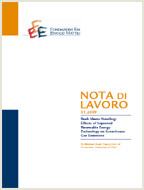Water Flows in the Economy. An Input-output Framework to Assess Water Productivity in the Castile and León Region (Spain)

Data
04.02.2015
04.02.2015
Autori
C. Dionisio Pérez Blanco (University of Alcalà UAH, Madrid Institute for Advanced Studies in Water Technologies IMDEA-Water); Thomas Thaler (Flood Hazard Research Center FHRC, Middlesex University)
Codice JEL
Q25, Q28
Q25, Q28
Parole chiave:
Environmental Input-output Modeling, Verdoorn’s Law, Water Management, Productivity
Environmental Input-output Modeling, Verdoorn’s Law, Water Management, Productivity
Publisher
Climate Change and Sustainable Development
Climate Change and Sustainable Development
Traditionally, water policy has focused on coordinating the public effort required to fuel economic growth by supplying water services demanded as a result of the progress in the many areas of the economy. Under this supply-oriented paradigm, population growth and the improvement of living standards brought about by development have driven water demand up and the pressures over water resources have escalated. The failure to acknowledge the limited availability of water and to decouple economic development from water demand has resulted in a water dependent growth model that in many areas is currently threatened by increasing scarcity and more frequent and intense droughts. Consequently, there is an urgent need to use sparse water resources in a sustainable and efficient way. This demands a comprehensive assessment of water productivity dynamics as well as of the linkages among economic sectors in order to calculate the actual costs of eventual water reallocations to the environment and establish priorities in the design of strategic actions such as river basin or drought management plans. However, available studies only offer static analyses that are insufficient to attain the dual objective of reverting current water scarcity trends without impairing economic growth. This paper develops a methodology based on the Hypothetical Extraction Method to estimate inter-temporal indirect (i.e., including intersectoral linkages) water productivity values. The method is applied in the Spanish region of Castile and León for the period 2000-2006. The intensive use and the low water productivity found for agriculture confirms the intuition that this sector has to play a fundamental role in any water saving policy. However, the relevant linkages between agriculture and the rest of the economy, which acts as an indirect consumer of water for irrigation, may complicate the finding of a Pareto improvement in water allocation. Results also show increasing returns to scale in the manufacturing industry and the service sector, which may be regarded as an evidence of the existence of a Verdoorn’s Law for water.
***
Suggested citation: Pérez Blanco, C.D.; Thaler, T. An Input-Output Assessment of Water Productivity in the Castile and León Region (Spain). Water 2014, 6, 929-944, http://www.mdpi.com/2073-4441/6/4/929.
